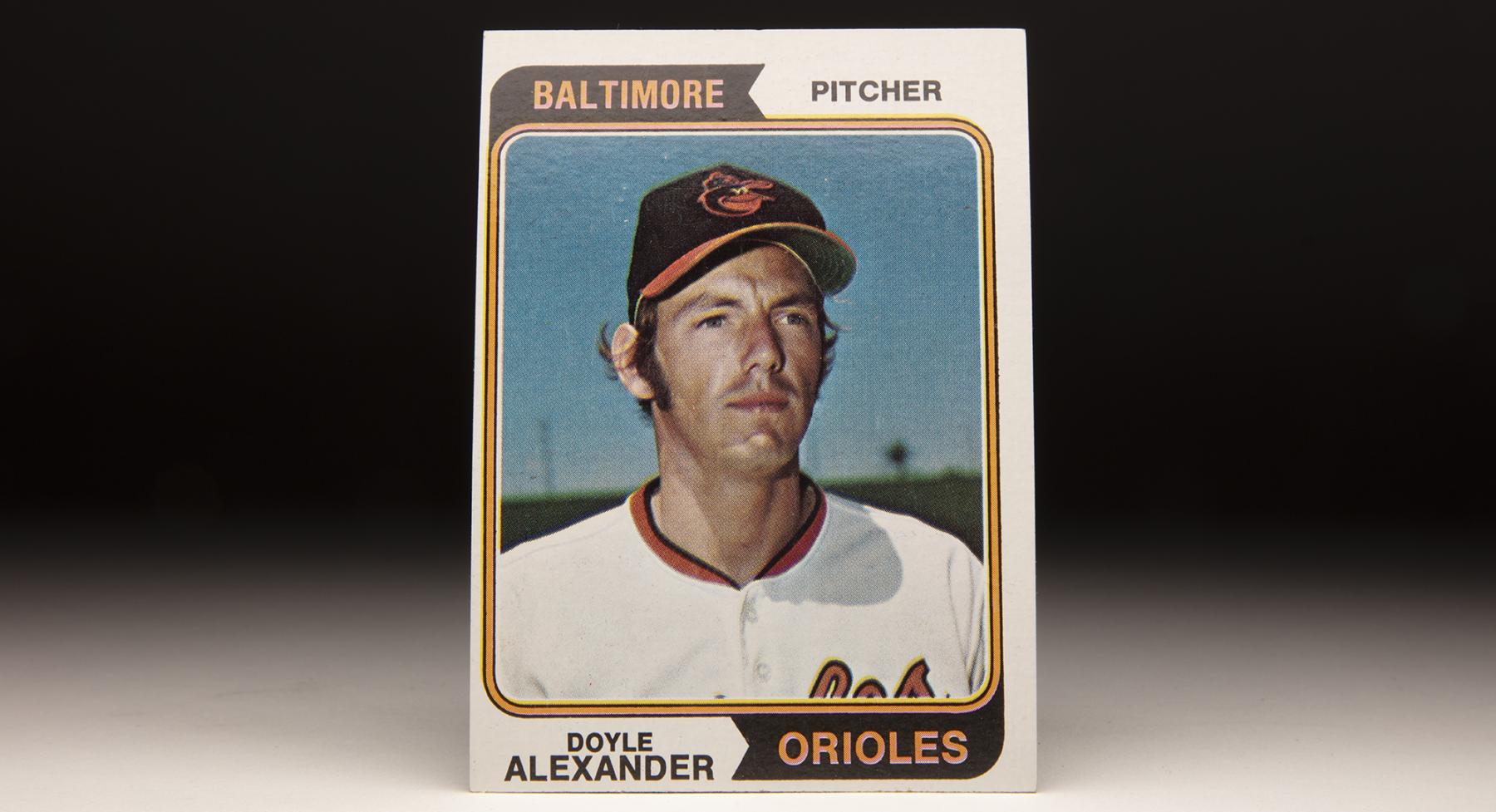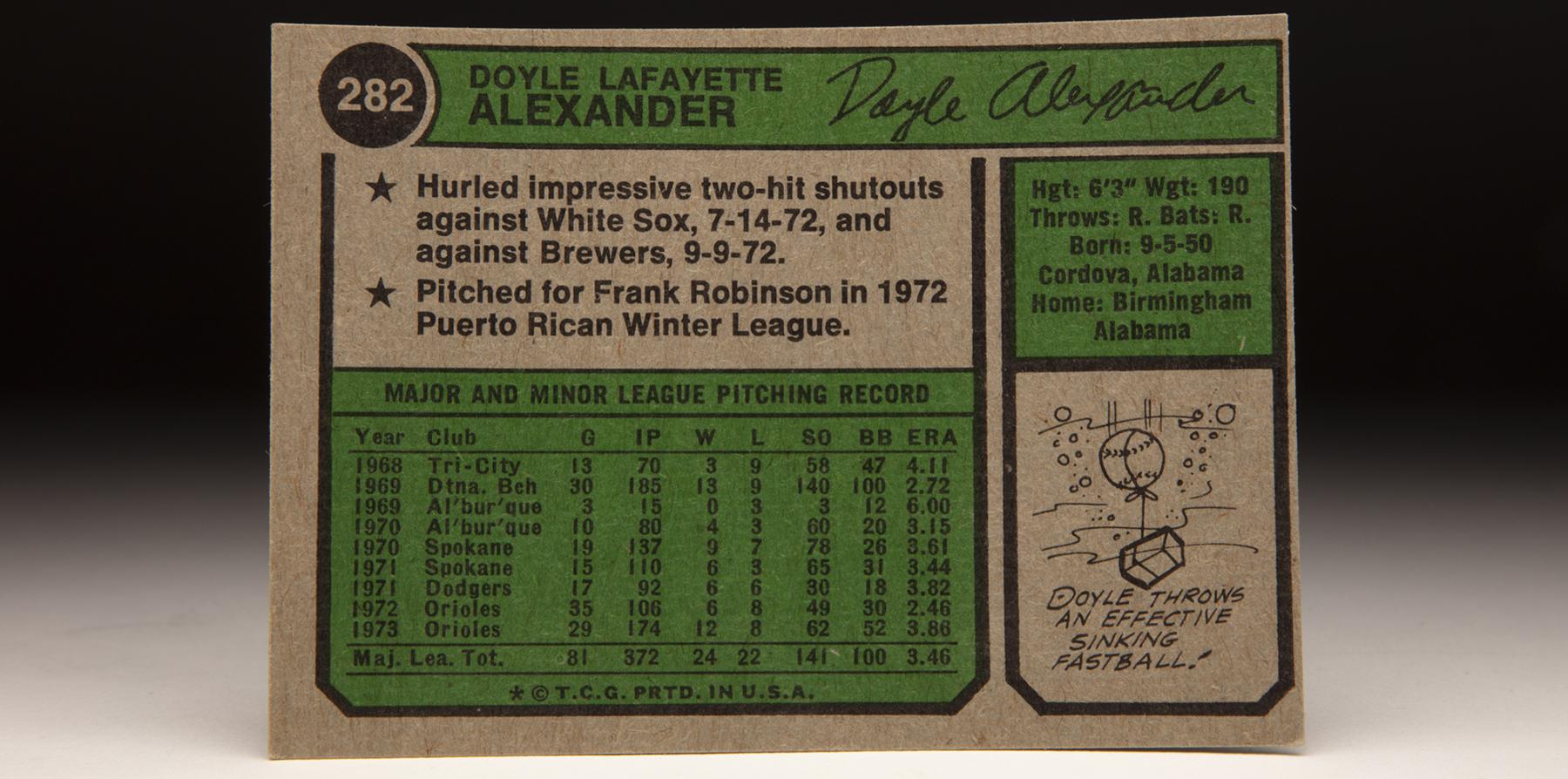- Home
- Our Stories
- #CardCorner: 1974 Topps Doyle Alexander
#CardCorner: 1974 Topps Doyle Alexander
History will forever record that Doyle Alexander, just shy of 37 years old and with a 5-10 record for the Atlanta Braves, was traded straight up for a future Hall of Famer on Aug. 12, 1987.
What that sentence fails to note, however, is that Alexander proceeded to become one of the best trade-deadline acquisitions in the history of the game – leading his new team, the Tigers, to a postseason berth. And while John Smoltz went onto a career that would bring him to Cooperstown, Tigers fans – in the fall of 1987 – had no qualms with the deal or the stellar work of Alexander.
Hall of Fame Membership
There is no simpler, and more essential, way to demonstrate your support than to sign on as a Museum Member.
Doyle Lafayette Alexander was born Sept. 4, 1950, in Cordova, Ala. – a textile mill town located about a half hour northwest of Birmingham. He played high school ball at Woodlawn in Birmingham, handling first base while not pitching and failing to attract much attention. As a freshman, he opted to play Pony League ball instead of for his high school team.
“I knew Doyle was competitive and a very hard worker,” Braves scout Dicky Martin told the Birmingham Post-Herald in 1989. “But I thought he was a little short velocity-wise. Very few people were interested in Doyle.”
But Joe Campbell, a part-time Dodgers scout who umpired many of Alexander’s games, thought the right-hander’s sinking fastball would play in professional baseball. The Dodgers took Alexander in the ninth round of the June 1968 MLB Draft.
“We kept him in town for eight days, hiding him out at the old airport apartments and working with him,” Campbell told the Post-Herald. “And then we signed him and sent him off to the Dodgers’ Tri-City team in the Northwest League.”
For a bonus of $1,500, the Dodgers got a pitcher who would one day be involved in two separate trades featuring future Hall of Famers.
“Fastball-wise, curveball-wise, Doyle was not a great pro prospect,” Tandy Gerelds, Alexander’s coach at Woodlawn High School, told the Post-Herald. “But he had that sinker at an early age.”
Alexander struggled in his first season in pro ball in 1968, going 3-9 with a 4.11 ERA for the Tri-City Atoms in Kennewick, Wash. But when he moved up to Class A Daytona Beach of the Florida State League in 1969, Alexander went 13-9 with a 2.72 ERA before earning a late-season promotion to Double-A Albuquerque. After a stint in the Arizona Instructional League after the season, Alexander began the 1970 campaign with Albuquerque and then moved to Triple-A Spokane – finishing the season with a combined record of 13-10 with a 3.44 ERA. His control for his age – he strung together 40 straight innings without a walk for Spokane – put him on the Dodgers’ radar, and the team invited him to its big league Spring Training camp in 1971 after a strong performance in the Dominican Winter League for manager Tommy Lasorda.
“He continues to keep the ball down,” Lasorda told the Post-Herald about Alexander in the late winter of 1971, “and he has uncanny control.”
Alexander was hopeful of making the Dodgers’ roster for Opening Day 1971 but was sent back to Spokane. However, after going 6-3 with a 3.44 ERA in 15 starts, Alexander was brought up to the Dodgers and immediately inserted into the starting rotation, allowing just two runs and no walks over eight innings in his first game against the Padres on June 26.
Alexander picked up his first big league win six days later against San Diego in a complete game effort and remained in the rotation for much of the rest of the season, going 6-6 with a 3.80 ERA in 92 innings. Then, on Dec. 2, Alexander has his first brush with Cooperstown when he was one of four players sent to the Orioles in exchange for Pete Richert and future Hall of Famer Frank Robinson.
“I knew (the Dodgers) were looking for some trades in the offseason to help the hitting, and I knew just about everybody could be traded for the right deal,” Alexander told the Post-Herald. “So I wasn’t really shocked about going to Baltimore.
“It will be like starting all over.”
Alexander joined an Orioles team that had won three straight American League pennants and featured a starting rotation with four 20-game winners – Mike Cuellar, Pat Dobson, Dave McNally and Jim Palmer – in 1971. With that quartet starting 143 of Baltimore’s 154 games in 1972, Alexander was limited to long relief and spot starts, going 6-8 with two saves and a 2.45 ERA in 35 games, including nine starts which produced two shutouts.
Following the 1972 season – when Baltimore failed to reach the postseason for the first time since 1968 – the Orioles traded Dobson and Roric Harrison, who was the only pitcher aside from the main quartet and Alexander to start a game for the team in 1972 – to the Braves. Alexander would assume Dobson’s place in the rotation in 1973. He missed much of July while sidelined with tendinitis in his throwing elbow but still made 26 starts, going 12-8 with a 3.86 ERA in 174.2 innings.
The Orioles won the AL East that year, and manager Earl Weaver called on Alexander to start Game 5 of the ALCS vs. the Athletics. With each team facing a win-or-go-home scenario, the A’s scored a run in the bottom of the third inning on a Joe Rudi single and added two more in the fourth on a Vic Davalillo RBI triple and a single by Jesús Alou, which chased Alexander from the mound. Catfish Hunter threw a five-hitter for Oakland as the A’s advanced to the World Series with a 3-0 win.
In 1974, Weaver returned to a four-man rotation – with Palmer, Cuellar and McNally joined by Ross Grimsley, who was acquired from the Reds in the offseason. The move pushed Alexander back into a swingman role, and he went 6-9 with a 4.01 ERA in 114.1 innings as the Orioles again won the AL East and again fell to Oakland in the ALCS.
Alexander did not pitch in the postseason.
Mike Torrez replaced McNally, who was traded to the Expos in a deal that brought Torrez to Baltimore, in the four-man rotation in 1975 – and Alexander remained a swingman, going 8-8 with a 304 ERA in 133.1 innings. He remained a spot starter in 1976 until June 15, when he was involved in a huge trade with the Yankees. The Orioles sent Jimmy Freeman, Elrod Hendricks, Ken Holtzman, Grant Jackson and Alexander to New York in exchange for Rick Dempsey, Tippy Martinez, Rudy May, Scott McGregor and Dave Pagan.
Alexander was 3-4 with a 3.50 ERA at the time of the trade, and the Yankees immediately inserted him into their starting rotation. He took a perfect game into the seventh inning against the Tigers on Aug. 2, finishing with a two-hit shutout, and went 5-1 overall in August while helping New York advance to the postseason for the first time since 1964 while going 10-5 with a 3.29 ERA in 19 starts for his new team.
Alexander did not pitch in the Yankees’ win over the Royals in the ALCS but drew the start in Game 1 of the World Series against Cincinnati due to New York having to go five games to beat Kansas City. He allowed five earned runs over six innings in a 5-1 loss to the Reds as Cincinnati swept the series.
Following the season, Alexander became a member of the first class of free agents and was selected by 12 clubs – the maximum allowed – in the free agent re-entry draft. On Nov. 23, he signed a six-year deal with the Rangers worth a reported $900,000.
“Now we can kind of settle back and concentrate on baseball for a while and let other problems take care of themselves,” Alexander, who was represented by pioneering agent Jerry Kapstein, told the Associated Press. “I’m very happy to be a member of the Texas Rangers.”
Alexander gave the Rangers everything they could ask for in 1977, going 17-11 with a 3.65 ERA in 237 innings. However, his strikeout-to-walk ratio was an ominous 1.00 (82 walks and 82 strikeouts), and no pitcher since Alexander in 1977 has won at least 17 games with a strikeout-to-walk mark of 1.00 or less.
In 1978, Alexander’s peripheral numbers were similar to the year before but he went just 9-10 with a 3.86 ERA. Then in 1979, Alexander lost command of the strike zone and went 5-7 with a 4.45 ERA, walking 69 while striking out 50.
On Dec. 6, 1979, the Rangers traded Alexander and Larvell Blanks to the Braves in exchange for Adrian Devine and Pepe Frías. The deal initially included Jeff Burroughs going back to the Rangers, but Burroughs invoked his no-trade clause.
Meanwhile, Alexander found his form again in Atlanta, going 14-11 with a 4.20 ERA in 35 starts, striking out 114 batters while walking 74. But Alexander was unhappy with his contract, and – per the collective bargaining agreement – demanded a trade following the 1980 season when the Braves declined to renegotiate. At the time, players who were traded and reached a certain level of service time could demand another trade after one season with their new team.
“It’ll be tough to leave (manager) Bobby Cox, as good as he’s been to me,” Alexander told the Associated Press. “And I’d like to stay. But right now, it’s 50/50 I’ll leave.”
On Dec. 12, 1980, the Braves traded Alexander to the Giants in exchange for John Montefusco and a minor leaguer. Alexander then proceeded to have what might have been his best season to date, going 11-7 with a 2.89 ERA in 24 starts in the strike-shortened 1981 season. But he remained dissatisfied with his contract and refused to report to Spring Training in 1982.
Alexander reportedly rejected trades to the Tigers and Royals that spring.
“As far as I’m concerned, he can sit out the season,” Giants general manager Tom Haller told the AP. “That may sound like a hard line, but we tried in good faith to make a trade.”
On March 30, the Giants finally found a trade partner when they sent Alexander back to the Yankees in exchange for Andy McGaffigan and Ted Wilborn. The Yankees quickly signed Alexander to a four-year extension worth a reported $2.2 million.
But Alexander’s return to New York was a rocky one. His holdout rankled some of his Yankees teammates, and he didn’t make his first appearance until April 24 as he worked back into pitching shape. In his third start, Alexander allowed five runs (but only one earned) in three innings against the Mariners – in a game where Gaylord Perry notched his 300th win – then punched a dugout wall in frustration and broke the pinky finger on his pitching hand. The injury sidelined Alexander for two months, and he agreed to forfeit $65,000 in salary because of the self-inflicted broken finger.
“It’s very simple: What I did was wrong,” Alexander told the AP. “I can’t hold (the Yankees) responsible for what I did.”
Alexander struggled upon his return, was sent to the minors and did not post his first victory until Sept. 28, finishing the big league season with a 1-7 record and 6.08 ERA. After starting the 1983 campaign 0-2 with a 6.35 ERA, Alexander was released on May 31. But Alexander rejoined his old friend Bobby Cox with the Blue Jays on June 21, and Alexander went 7-6 with a 3.93 ERA in 116.2 innings for Toronto during the rest of 1983.
Then in 1984, Alexander pitched like the ace he had seemed destined to become a decade before. He led the Jays with 17 wins against only six losses, topping all pitchers with a .739 winning percentage while working a career-best 261.2 innings. He virtually duplicated that season a year later, going 17-10 with a 3.45 ERA in 260.2 innings while finishing sixth in the AL Cy Young Award voting.
Toronto won the AL East, and Alexander started Game 3 of the ALCS vs. the Royals, allowing five runs over five innings while earning a no-decision. He returned to start Game 5 and this time allowed five runs over 5.1 innings, taking the loss in a 5-3 Kansas City win. The Royals would win Game 7 to advance to the World Series.
In 1986, Alexander asked for a contract extension as he entered the last year of his contract. When the Blue Jays refused, Alexander asked to be traded – and Toronto sent him back to the Braves, where Cox was now the general manager, in exchange for Duane Ward on July 6. It would be a deal that would pay dividends for the Blue Jays for years – but also one that would benefit the Braves after yet another trade involving Alexander.
“I feel right now I’m a better pitcher than I’ve ever been,” Alexander told the Atlanta Constitution after the trade. “I’m happy to be with Atlanta. I enjoyed my year in Atlanta. I really didn’t want to leave, but that happens.”
Alexander finished the season with an overall record of 11-10 and a 4.14 ERA. But he found no suitable offers following the year and sat out Spring Training, coming to terms with the Braves on May 5, 1987, on a two-year deal worth a reported $1.5 million. He was 5-10 with a 4.13 ERA through 16 starts when the Braves sent him to the Tigers on Aug. 12 for a little-known minor leaguer named John Smoltz.
Alexander then proceeded to pitch the Tigers into the postseason, going 9-0 with a 1.53 ERA in 11 starts as Detroit caught and passed Toronto in the AL East. The Tigers began the final three games of the season against Toronto trailing by one game, and Alexander started the first game of the series on Oct. 2. After allowing a three-run homer to Manuel Lee in the second inning, Alexander blanked the Blue Jays over five innings, inducing three double play balls. Mike Henneman closed the door in the eighth and ninth to give Detroit a 4-3 win, leaving the teams in a tie atop the division. Detroit won the next two games – both coming by one run as well – to take the title.
“He really provided us with the spark we needed,” Tigers coach Alex Grammas told the Post-Herald during the late summer of 1987. “When you get somebody like that, who starts doing what he did for us, it kind of ignites everybody else. We had a good team that year anyway, but when Doyle came over and pitched the way he did, it sort of snowballed. It made everyone else play better and not just in his games but all the time.”
Alexander started Games 1 and 5 of the ALCS vs. the Twins but was unable to duplicate his regular season magic, allowing six runs over 7.1 innings in the opener and then getting knocked out of the box in the second inning of Game 5 as the Twins scored four times en route to a 9-5 series-clinching win.
Alexander went 14-11 with a 4.32 ERA in 1988, earning his first All-Star Game selection but voicing displeasure with his contract, which was due to expire at the end of the year. He re-signed with Detroit on Jan. 13, 1989, for one year and a reported $1.1 million, but the 1989 season saw the Tigers lose 103 games and Alexander post a 6-18 record and 4.44 ERA over 223 innings while leading the AL with 28 homers allowed.
When the Tigers did not offer Alexander a contract for the 1990 season, his career came to an end. Over 19 big league seasons, Alexander was 194-174 with a 3.76 ERA. Often vilified for his contract demands and taciturn nature, Alexander pitched well for some of the best teams of his era – and was routinely traded for players who would star for their new franchises.
“Doyle is basically quiet,” Tigers coach Alex Grammas told the Post-Herald during Alexander’s incredible late-season stretch. “He’s willing to talk, but generally speaking, you have to initiate the conversation. He minds his own business, and lets his actions speak for him.”
Craig Muder is the director of communications for the National Baseball Hall of Fame and Museum
Related Stories

#CardCorner: 1974 Topps Gary Matthews
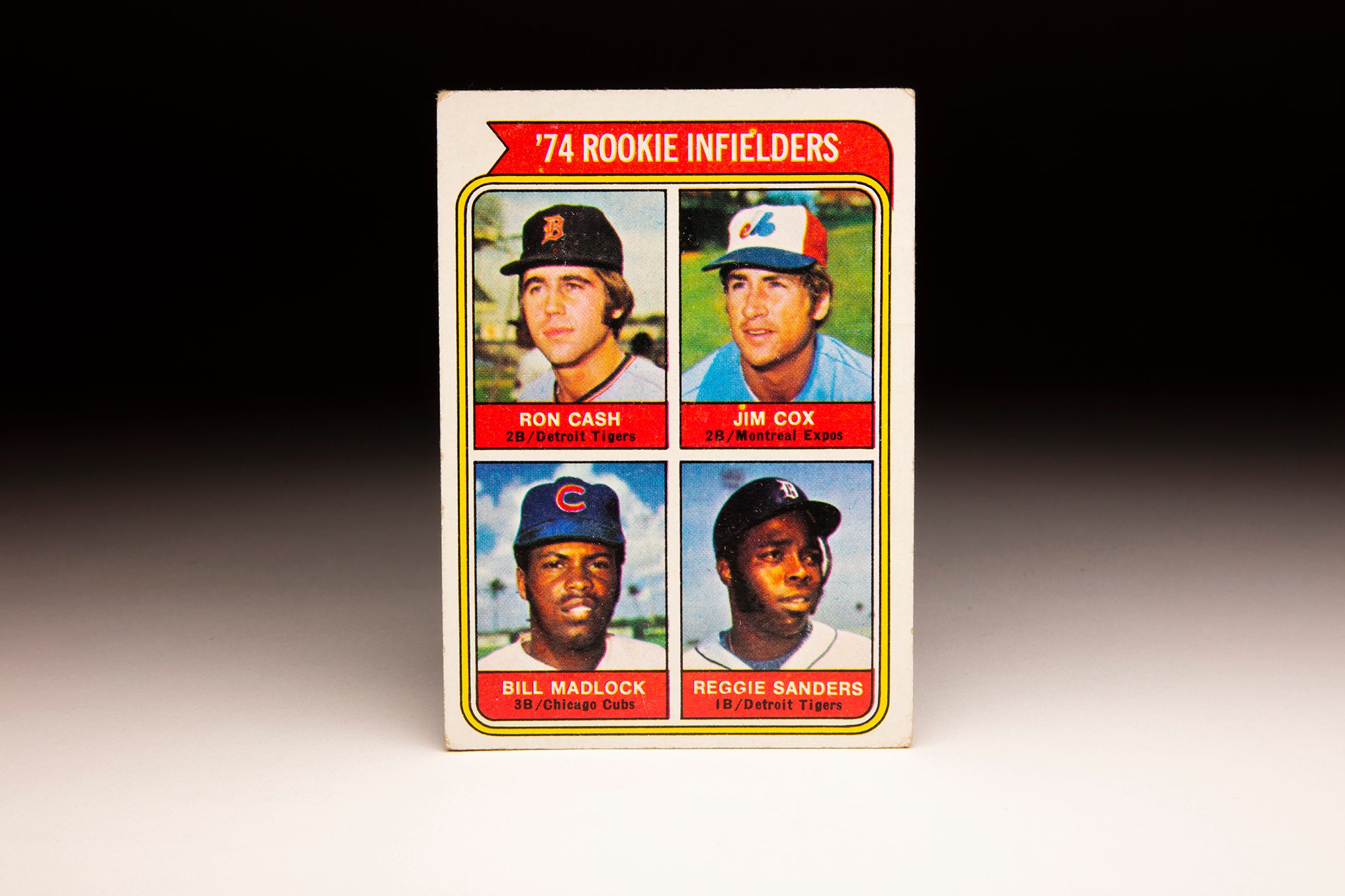
#CardCorner: 1974 Topps Bill Madlock
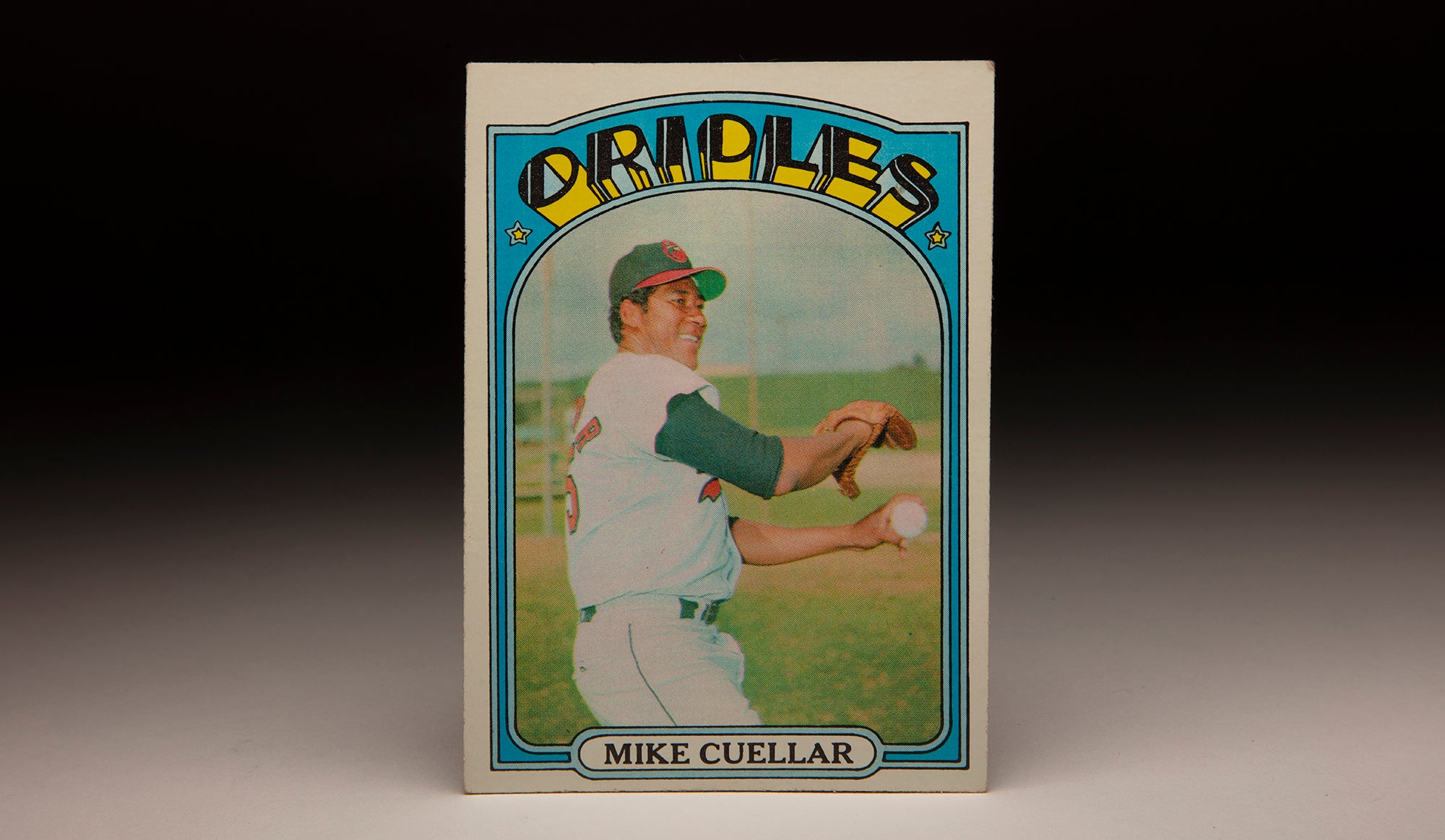
#CardCorner: 1972 Topps Mike Cuellar
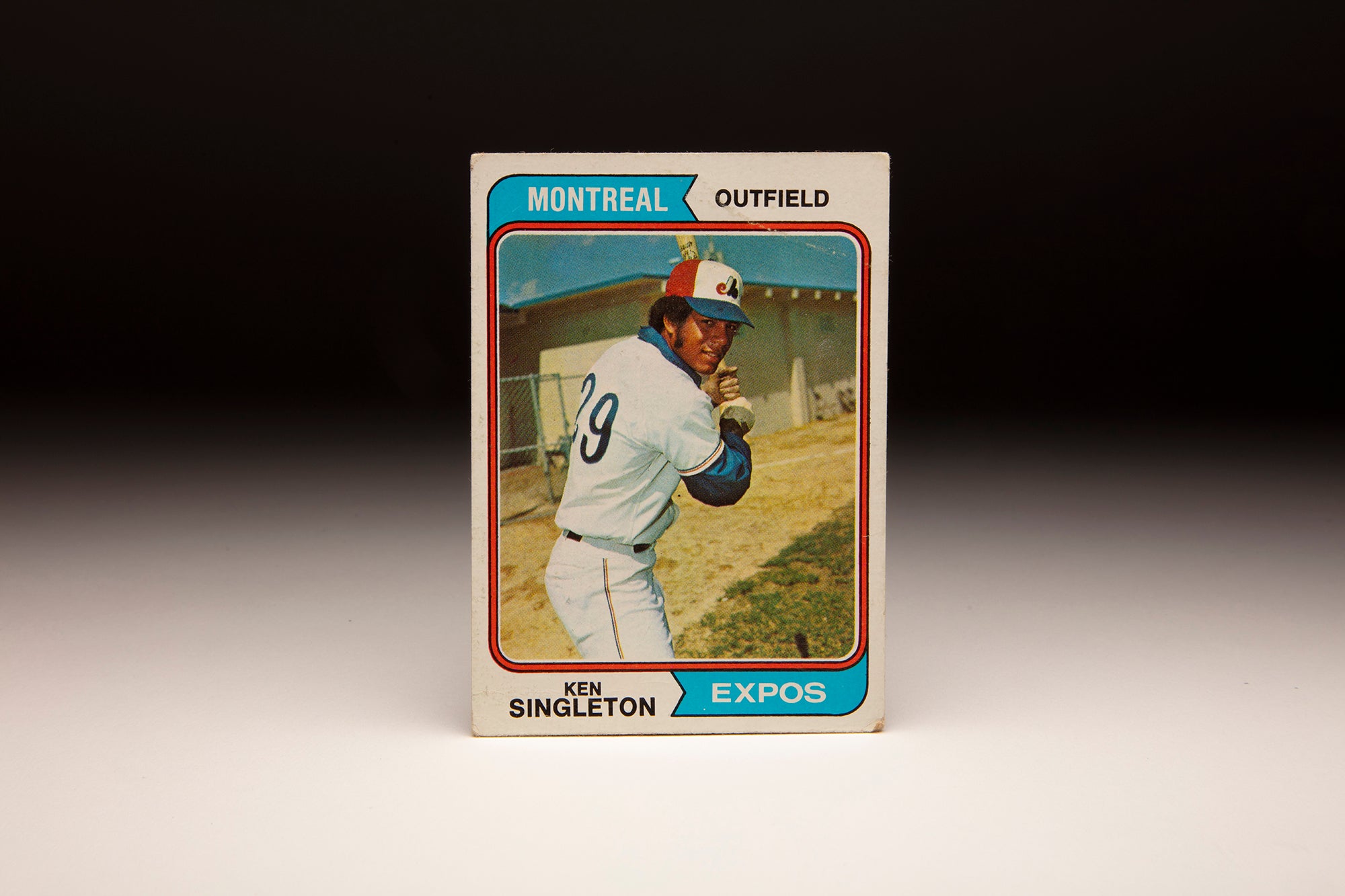
#CardCorner: 1974 Topps Ken Singleton
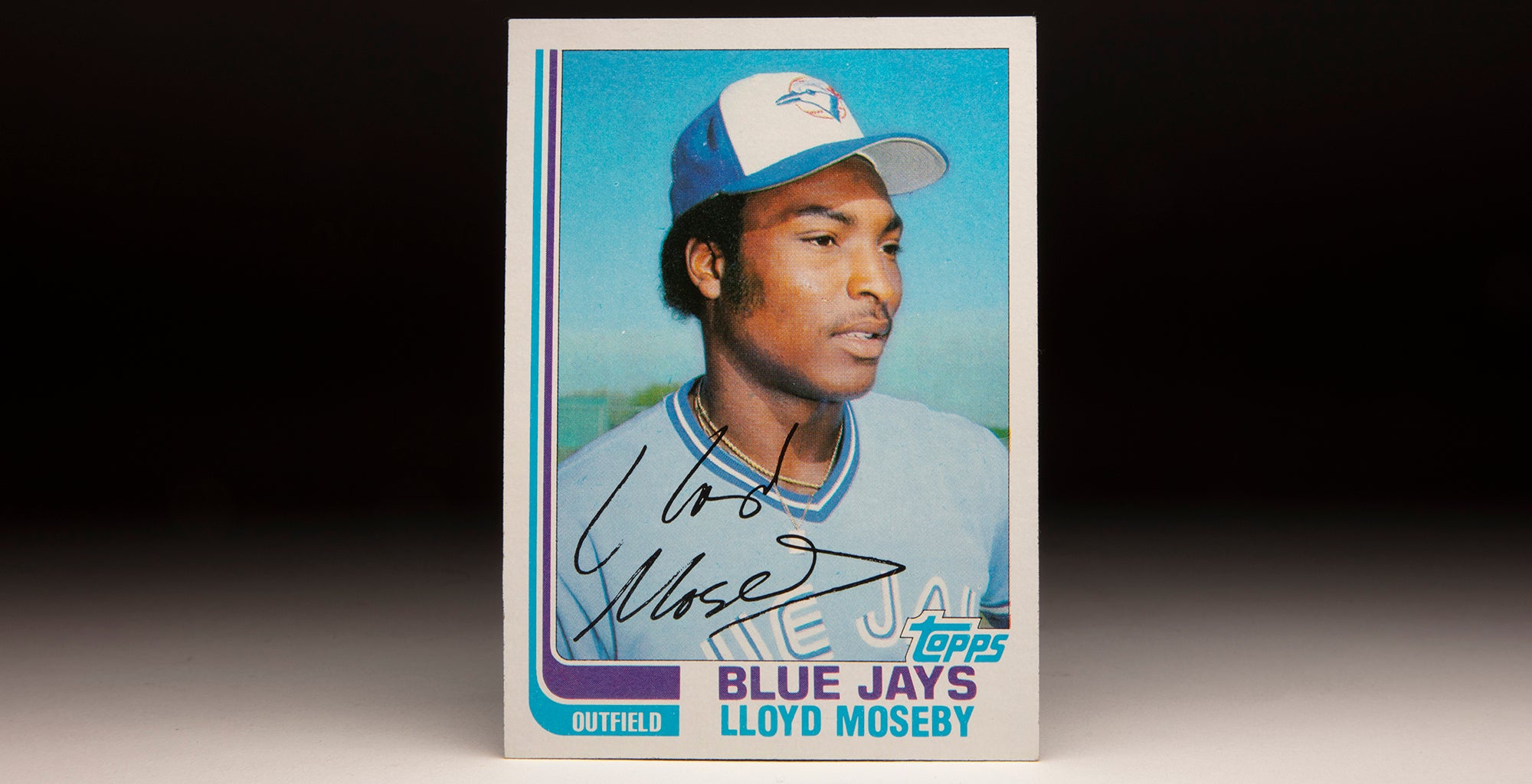
#CardCorner: 1982 Topps Lloyd Moseby
Related Stories

Oliva’s opening day homer makes DH history

Harmon Killebrew Hits His 500th Career Home Run
Cap Selections Announced for Craig Biggio, Pedro Martinez and John Smoltz

World Series Glory Awaits

#CardCorner: 1972 Topps Jim Roland

#CardCorner: 1974 Topps Doyle Alexander

King John Schuerholz

#CardCorner: 1974 Topps Doyle Alexander
Hall of Fame Induction Weekend Visitors Urged to Utilize Special Parking Options
Hall of Fame Staff Members Answer Pro Football Hall of Fame #ALSIceBucketChallenge
01.01.2023
Today’s Game Era Committee Ballot to Be Considered Dec. 4 at Baseball’s Winter Meetings
01.01.2023

